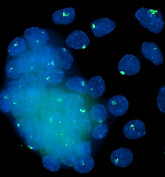









Climate change and maternal-child health Laboratory
Department of Developmental Biology and Genetics, Division of Biological Science
Indian Institute of Science, Bangalore, India



RESEARCH
Emerging evidence implicates that epigenetics plays a major role in developmental processes. However, often dysregulation of epigenetic processes leads to different human diseases such as cancer. Unlike irreversible mutations in DNA, epigenetic modifications are reversible. This inherent plasticity makes epigenetic changes associated with human diseases potentially amenable to manipulation via therapeutic intervention. Therefore, understanding of epigenetic regulation is crucial for our comprehension of the alterations that can lead to disease. However, much about the mechanistic aspects of epigenetic regulation remains to be understood. Our research strives to further understand the mechanism of epigenetic regulation of gene expression in different biological contexts.
Understanding the detrimental consequences of global warming induced heat humidity stress (HS) on mammalian embryonic development

Climate change is no longer a myth, it is happening right now, everywhere. Our planet is experiencing a rapid rise in temperature, accompanied by a concerning increase in the frequency of heat waves and extreme humidity.
This poses an existential threat to species - including humans. Studies predict sub-optimal temperature-humidity conditions might be one of the major reasons for the elevated rates of human health concerns including pregnancy complications, birth defects, and late onset disorders. To gain a definitive understanding of the underlying factors and develop effective strategies, robust scientific investigation is necessary which is lacking.
Our lab is interested in looking into the molecular and epigenetic basis of heat-humidity stress vulnerability of mammalian pregnancy using a mouse gestational-HS model that we have established. We aim to focus on the teratogenicity of high heat-humidity and how it can perturb mouse embryonic development both at the morphological and molecular scales. Our preliminary results indeed suggests that HS causes severe perturbation of mouse embryogenesis and that gets reverberated postnatally to some extent.
Using transcriptomic, epitranscriptomic and epigenomic quantification in control vs HS embryos, we further wish to explore the underlying phenomenon -- some driver pathways that gets haywire or some target genes and whether we could use those as a therapeutic target for modelling human intervention strategies.
Understanding X-chromosome reactivation dynamics during reprograming of primed to naive pluripotency in mouse

During development, pluripotency first arises in the inner cell mass of pre-implantation blastocyst in a naïve state and progresses to a primed state in the post-implantation epiblast that is then lost upon lineage commitment. These transient pluripotent states in vivo are recapitulated in vitro. Mouse embryonic stem cells (ESC) represent the naïve state, whereas mouse epiblast stem cells (EpiSC) represent the primed state. One hallmark epigenetic change during transition from naïve to primed pluripotent state in female cells is X-chromosome inactivation.
During X-inactivation, one of the two X-chromosomes in female mammals is transcriptionally inactivated in order to equalize X-linked gene expression between the sexes. Once inactivated, replicated copies of the inactive and the active-X maintain their respective transcriptional states through future rounds of cell division. X-inactivation is essential for the viability and proper development of female mammals and serves as a paradigm of epigenetic transcriptional regulation.
Notably, reprogramming of primed pluripotent state to naïve state leads to the reactivation of the inactive-X. An open question is whether X-reactivation is necessary for reversion of primed state to naïve state or it is merely a consequence of the acquisition of naïve state. Additionally, how X-chromosome reactivation is facilitated during the reprogramming of primed to naïve pluripotency is not fully clear. We have recently obtained data showing that the ectopic inactivation of one of the two X-chromosomes in female ESC does not perturb their naïve state. Based on this preliminary evidence, we hypothesize that XCR is not a cause but a consequence of the acquisition of naïve pluripotency. Notably, despite much work, the molecular link between naïve pluripotency and X-chromosome reactivation has remained elusive. The current objective therefore, is to delineate how acquisition of naïve pluripotency converges with the activation of the pathways that reactivate the inactive-X during the reprogramming of primed to naïve pluripotent state.
Understanding the mechanism of semi-coordinated transcriptional bursting and how it drives development
In recent years, allele-specific single-cell RNA-seq (scRNA-seq) analysis has demonstrated widespread dynamic random monoallelic expression of autosomal genes (aRME) in different cell types. However, the prevalence of dynamic aRME during pre-gastrulation development remains unknown.
We found that dynamic aRME is widespread in different lineages of pre-gastrulation embryos. Additionally, the origin of dynamic aRME remains poorly understood. Theoretically, it is believed that independent transcriptional bursting from each allele leads to the dynamic aRME. However, the kinetics of allele- specific bursting and its relation to the dynamic aRME remains poorly understood. Recently, through genome-wide profiling of allele-specific burst kinetics, we show that allelic burst is not perfectly independent, instead it happens in semi-coordinated fashion.
Importantly, we show that semi-coordinated allelic bursting of the genes, particularly with low burst frequency, leads to frequent asynchronous allelic bursting, thereby shaping the landscape of dynamic aRME.

Furthermore, we found that many genes have differences in the degree of coordination of allelic bursting between the developmental lineages, implicating the biological significance of allelic burst kinetics. Interestingly, genes regulating the development have a higher degree of coordination of allelic bursting. Currently, we are exploring the mechanistic aspect of semi-coordinated transcriptional bursting and it's biological significance specially during the early development.